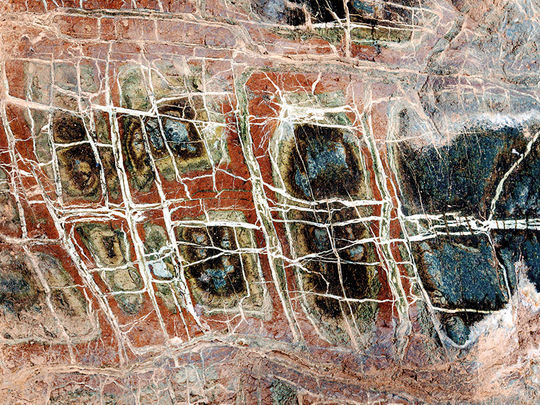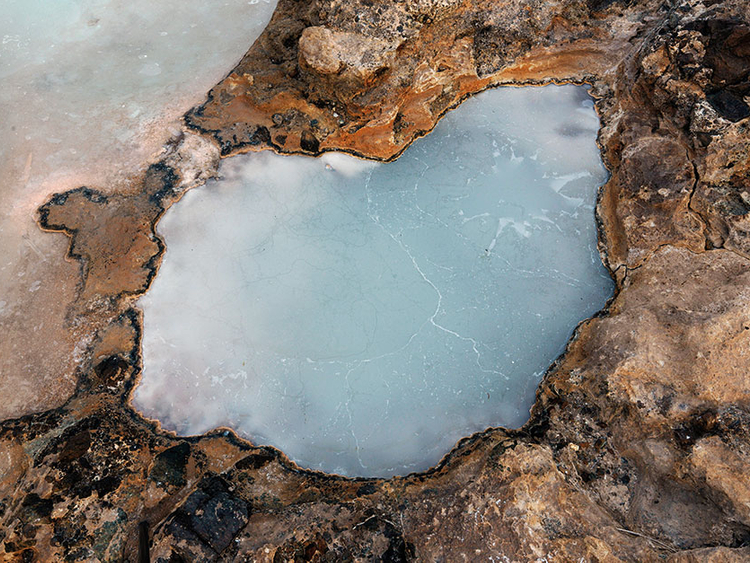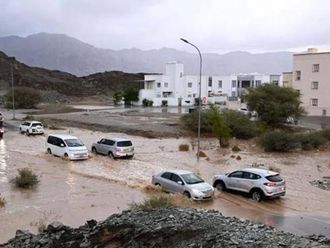
Ibra, Oman: In the arid vastness of this corner of the Arabian Peninsula, out where goats and the occasional camel roam, rocks form the backdrop practically every way you look.
But the stark outcrops and craggy ridges are more than just scenery. Some of these rocks are hard at work, naturally reacting with carbon dioxide from the atmosphere and turning it into stone.
Veins of white carbonate minerals run through slabs of dark rock like fat marbling a steak. Carbonate surrounds pebbles and cobbles, turning ordinary gravel into natural mosaics.
Even pooled spring water that has bubbled up through the rocks reacts with CO2 to produce an icelike crust of carbonate that, if broken, re-forms within days.
Scientists say that if this natural process, called carbon mineralisation, could be harnessed, accelerated and applied inexpensively on a huge scale — admittedly some very big “ifs” — it could help fight climate change. Rocks could remove some of the billions of tons of heat-trapping carbon dioxide that humans have pumped into the air since the beginning of the Industrial Age.
And by turning that CO2 into stone, the rocks in Oman — or in a number of other places around the world that have similar geological formations — would ensure that the gas stayed out of the atmosphere forever.
“Solid carbonate minerals aren’t going anyplace,” said Peter B. Kelemen, a geologist at Columbia University’s Lamont-Doherty Earth Observatory who has been studying the rocks here for more than two decades.
Capturing and storing carbon dioxide, is drawing increased interest. The Intergovernmental Panel on Climate Change says that deploying such technology is essential to efforts to rein in global warming. But the idea has barely caught on: There are fewer than 20 large-scale projects in operation around the world, and they remove CO2 from the burning of fossil fuels at power plants or from other industrial processes and store it as gas underground.
What Kelemen and others have in mind is removing carbon dioxide that is already in the air, to halt or reverse the gradual increase in atmospheric CO2 concentration. Direct-air capture, as it is known, is sometimes described as a form of geoengineering — deliberate manipulation of the climate — although that term is more often reserved for the idea of reducing warming by reflecting more sunlight away from the earth.
Although many researchers dismiss direct-air capture as logistically or economically impractical, especially given the billions of tons of gas that would have to be removed to have an impact, some say it may have to be considered if other efforts to counter global warming are ineffective.
A few researchers and companies have built machines that can pull CO2 out of the air, in relatively small quantities, but adapting and enhancing natural capture processes using rocks is less developed.
“This one still feels like the most nascent piece of the conversation,” said Noah Deich, executive director of the Center for Carbon Removal, a research organisation in Berkeley, California. “You see these sparks, but I don’t see anything catching fire yet.”
Kelemen is one of a relative handful of researchers around the world who are studying the idea. At a geothermal power plant in Iceland, after several years of experimentation, an energy company is injecting modest amounts of carbon dioxide into volcanic rock, where it becomes mineralised. Dutch researchers have suggested spreading a kind of crushed rock along coastlines to capture CO2. And scientists in Canada and South Africa are studying ways to use mine wastes, called tailings, to do the same thing.
“It’s clear that we’re going to have to remove carbon dioxide from the atmosphere,” said Roger Aines, who leads the development of carbon management technologies at Lawrence Livermore National Laboratory in California and has worked with Dr. Kelemen and others. “And we’re going to have to do it on a gigaton scale.”
If billions of tons of CO2 are to be turned to stone, there are few places in the world more suitable than Oman, a sultanate with a population of 4 million and an economy based on oil and, increasingly, tourism.
The carbon-capturing formations here, consisting largely of a rock called peridotite, are in a slice of oceanic crust and the mantle layer below it that was thrust up on land by tectonic forces nearly 100 million years ago. Erosion has resulted in a patchy zone about 321km long, up to 40km wide and several kilometres thick in the northern part of the country, including here in the outskirts of Ibra, a dusty inland city of 50,000. Even the bustling capital, Muscat, on the Gulf of Oman, has a pocket of peridotite practically overlooking Sultan Qaboos Bin Said’s palace.
Peridotite normally is miles below the earth’s surface. When the rocks are exposed to air or water as they are here, Kelemen said, they are like a giant battery with a lot of chemical potential. “They’re really, really far from equilibrium with the atmosphere and surface water,” he said.
The rocks are so extensive, Kelemen said, that if it was somehow possible to fully use them they could store hundreds of years of CO2 emissions. More realistically, he said, Oman could store at least a billion tons of CO2 annually.
While the formations here are special, they are not unique. Similar though smaller ones are found in Northern California, Papua New Guinea and Albania, among other places.
The rocks here may be capable of capturing a lot of carbon dioxide, but the challenge is doing it much faster than nature, in huge amounts and at low enough cost to make it more than a pipe dream. Kelemen and his colleagues, including Juerg Matter, a researcher from the University of Southampton in England who was involved in the Icelandic project, have some ideas.
One possibility, Kelemen said, would be to drill pairs of wells and pump water with dissolved CO2 into one of them. As the water travelled through the rock formation carbonate would form; when it reached the other well the water, now depleted of CO2, would be pumped out. The process could be repeated over and over.
There is a lot that is unknown about such an approach, however. For one thing, while pumping water deep into the earth, where temperatures and pressures are higher, could make the process of mineralisation go tens of thousands of times faster, so much carbonate might form that the water flow would stop. “You might clog everything up, and it would all come to a screeching halt,” Kelemen said.
Experiments and eventually pilot projects are needed to better understand and optimise this process and others, Kelemen said, but so far Omani officials have been reluctant to grant the necessary permits. The researchers may need to go elsewhere, like California, where the rocks are less accessible but the state government has set ambitious targets for reducing emissions and is open to new ways to meet them.
Kelemen and Aines have had preliminary discussions with California officials about the possibility of experimenting there. “We would certainly be a willing and eager partner to help them with it,” said David Bunn, director of the state Department of Conservation.
Perhaps the simplest way to use rocks to capture carbon dioxide would be to quarry large amounts of them, grind them into fine particles and spread them out to expose them to the air. The material could be turned over from time to time to expose fresh surfaces, or perhaps air with a higher CO2 concentration could be pumped into it to speed up the process.
But a quarrying and grinding operation of the scale required would be hugely expensive, scar the landscape and produce enormous CO2 emissions of its own. So a few researchers are asking, Why not use rocks that have been quarried and ground up for other purposes?
Such rocks are found in large amounts at mines around the world, as waste tailings. Platinum, nickel and diamonds, in particular, are mined from rock that has a lot of carbon-mineralisation potential.













